|

by Leslie Mullen
March 11, 2010
from
AstroBio Website
|
Summary:
Is our Sun part of a binary
star system?
An unseen companion star,
nicknamed “Nemesis,” may be sending comets towards Earth. If Nemesis
exists, NASA’s new WISE (Wide-field Infrared Survey Explorer)
telescope should be able to spot it. |
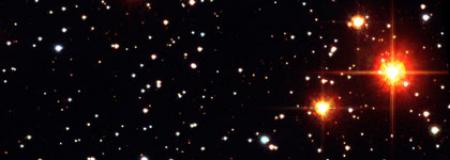

Size comparison
of our Sun, a low mass star, a brown dwarf, Jupiter, and Earth.
Stars with less
mass than the Sun are smaller and cooler, and hence much fainter in
visible light.
Brown dwarfs
have less than eight percent of the mass of the Sun,
which is not
enough to sustain the fusion reaction that keeps the Sun hot.
These cool orbs
are nearly impossible to see in visible light, but stand out when
viewed in infrared.
Their diameters
are about the same as Jupiter's, but they can have
up to 80 times
more mass and are thought to have planetary systems of their own.
Image credit: NASA
A dark object may be lurking near our solar system, occasionally
kicking
comets in our direction.
Nicknamed “Nemesis” or “The Death Star,” this undetected object
could be a red or brown dwarf star, or an even darker presence
several times the mass of Jupiter.
Why do scientists think something could be hidden beyond the edge of
our solar system? Originally, Nemesis was suggested as a way to
explain a cycle of mass extinctions on Earth.
The paleontologists David Raup and Jack Sepkoski claim
that, over the last 250 million years, life on Earth has faced
extinction in a 26-million-year cycle. Astronomers proposed comet
impacts as a possible cause for these catastrophes.
Our solar system is surrounded by a vast collection of icy bodies
called the Oort Cloud. If our Sun were part of a binary system in
which two gravitationally-bound stars orbit a common center of mass,
this interaction could disturb the Oort Cloud on a periodic basis,
sending comets whizzing towards us.
An asteroid impact is famously responsible for the extinction of the
dinosaurs 65 million years ago, but large comet impacts may be
equally deadly. A comet may have been the cause of
the Tunguska
event in Russia in 1908. That explosion had about a thousand times
the power of the atomic bomb dropped on Hiroshima, and it flattened
an estimated 80 million trees over an 830 square mile area.
While there’s little doubt about the destructive power of cosmic
impacts, there is no evidence that comets have periodically caused
mass extinctions on our planet. The theory of periodic extinctions
itself is still debated, with many insisting that more proof is
needed.
Even if the scientific consensus is that
extinction events don’t occur in a predictable cycle, there are now
other reasons to suspect a dark companion to the Sun.
The
Footprint of Nemesis
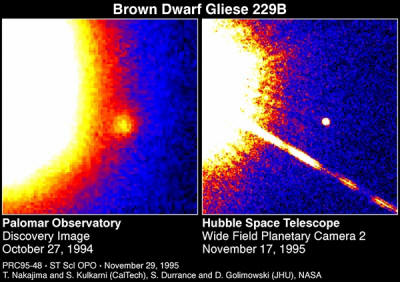
The smaller
object in these two photos is a brown dwarf that orbits the star
Gliese 229.
Located in the
constellation Lepus and about 19 light years from Earth,
the brown dwarf
Gliese 229B is about 20 to 50 times the mass of Jupiter.
Image credit:
NASA
A recently-discovered dwarf planet, named
Sedna, has an extra-long and usual
elliptical orbit around the Sun.
Sedna is one of the most distant objects
yet observed, with an orbit ranging between 76 and 975 AU (1
AU = distance between the Earth and the Sun). Sedna’s orbit is
estimated to last between 10.5 to 12 thousand years.
Sedna’s discoverer, Mike Brown of
Caltech, noted in a Discover magazine article that Sedna’s location
doesn’t make sense.
"Sedna shouldn't be there,” said
Brown. “There's no way to put Sedna where it is. It never comes
close enough to be affected by the Sun, but it never goes far
enough away from the Sun to be affected by other stars.”
Perhaps a massive unseen object is
responsible for Sedna’s mystifying orbit, its gravitational
influence keeping Sedna fixed in that far-distant portion of space.
“My surveys have always looked for
objects closer and thus moving faster,” Brown told Astrobiology
Magazine. “I would have easily overlooked something so distant
and slow moving as Nemesis.”
John Matese, Emeritus Professor
of Physics at the University of Louisiana at Lafayette, suspects
Nemesis exists for another reason.
The comets in the inner solar system
seem to mostly come from the same region of the
Oort Cloud, and Matese thinks the
gravitational influence of a solar companion is disrupting that part
of the cloud, scattering comets in its wake. His calculations
suggest Nemesis is between 3 to 5 times the mass of Jupiter, rather
than the 13 Jupiter masses or greater that some scientists think is
a necessary quality of a brown dwarf.
Even at this smaller mass, however, many
astronomers would still classify it as a low mass star rather than a
planet, since the circumstances of birth for stars and planets
differ.
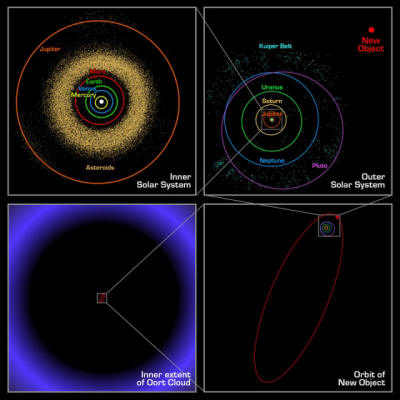
The “New Object” labeled in this image is Sedna,
a dwarf planet with
a 12,000-year orbit around the Sun.
It’s a mystery why Sedna has
such an elongated orbit.
The Oort Cloud is thought to extend about 1 light year from the Sun.
Matese estimates Nemesis is 25,000 AU away (or about one-third of a
light year). The next-closest known star to the Sun is
Proxima
Centauri, located 4.2 light years away.
Richard Muller of the University of California Berkeley first
suggested the Nemesis theory, and even wrote a popular science book
on the topic. He thinks Nemesis is a red dwarf star 1.5 light years
away. Many scientists counter that such a wide orbit is inherently
unstable and could not have lasted long - certainly not long enough
to have caused the extinctions seen in Earth’s fossil record.
But Muller says this instability has
resulted in an orbit that has changed greatly over billions of
years, and in the next billion years Nemesis will be thrown free of
the solar system.
Binary star systems are common in the galaxy. It is estimated that
one-third of the stars in the Milky Way are either binary or part of
a multiple-star system.
-
Red dwarfs are also common - in fact, astronomers say they
are the most common type of star in the galaxy.
-
Brown dwarfs
are also thought to be common, but there are only a few hundred
known at this time because they are so difficult to see.
Red and brown dwarfs are smaller and
cooler than our Sun, and do not shine brightly.
If red dwarfs can be
compared to the red embers of a dying fire, then brown dwarfs would
be the smoldering ash. Because they are so dim, it is plausible that
the Sun could have a secret companion even though we’ve searched the
sky for many years with a variety of instruments.
NASA’s newest telescope, the Wide-field Infrared Survey Explorer
(WISE),
may be able to answer the question about Nemesis once and for all.
Finding Dwarfs
in the Dark

Illustration of
the “Oort Cloud,”
a vast region
of comets thought to extend a light year beyond our Sun.
Image credit: NASA/JPL/Donald K. Yeoman
WISE looks at our universe in the infrared part of the spectrum.
Like the
Spitzer space telescope, WISE is hunting for heat. The
difference is that WISE has a much wider field of view, and so is
able to scan a greater portion of the sky for distant objects.
WISE began scanning the sky on January 14, and NASA recently
released the mission’s first images. The mission will map the entire
sky until October, when the spacecraft’s coolant runs out.
Part of the WISE mission is to search for brown dwarfs, and NASA
expects it could find one thousand of the dim stellar objects within
25 light years of our solar system.
Davy Kirkpatrick at NASA’s Infrared Processing and
Analysis Center at Caltech found nothing when he searched for
Nemesis using data from the Two Micron All Sky Survey (2MASS).
Now
Kirkpatrick is part of the WISE science team, ready to search again
for any signs of a companion to our Sun.
Kirkpatrick doesn’t think Nemesis will be the red dwarf star with an
enormous orbit described by Muller.
In his view, Matese’s description of
Nemesis as a low mass object closer to home is more plausible.
“I think the possibility that the
Sun could harbor a companion of another sort is not a crazy
idea,” said Kirkpatrick. “There might be a distant object in a
more stable, more circular orbit that has gone unnoticed so
far.”
Ned Wright, professor of astronomy and
physics at UCLA and the principal investigator for the WISE mission,
said that WISE will easily see an object with a mass a few times
that of Jupiter and located 25,000 AU away, as suggested by Matese.
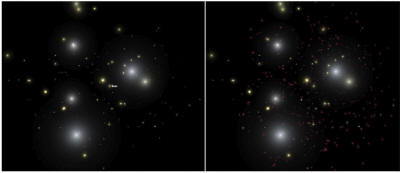
Astronomers
think there could be as many brown dwarfs as stars like our Sun,
but brown
dwarfs are often too cool to find using visible light.
Using infrared
light, the WISE mission could find many brown dwarfs within 25 light
years of the Sun.
These two
pictures show simulated data before and after the WISE mission
(stars are not real).
The simulated
picture on the left shows known stars (white and yellow) and brown
dwarfs (red) in our solar neighborhood.
The picture on
the right shows additional brown dwarfs WISE is expected to find.
Image credit: NASA/JPL-Caltech
“This is because Jupiter is
self-luminous like a brown dwarf,” said Wright. “But for planets
less massive than Jupiter in the far outer solar system, WISE
will be less sensitive.”
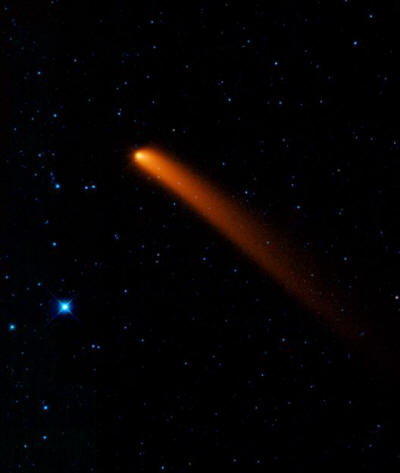
Comet “Siding
Spring” appears to streak across the sky like a superhero
in this new
infrared image from NASA's Wide-field Infrared Survey Explorer, or
WISE.
WISE will be
looking for comets and asteroids that might pose a threat to Earth.
Image credit: NASA/JPL-Caltech/UCLA
Neither Kirkpatrick nor Wright think Nemesis is disrupting the Oort
cloud and sending comets towards Earth, however. Because they
envision a more benign orbit, they prefer the name "Tyche" (the good
sister).
Regardless of what they expect to find, the WISE search won’t focus
on one particular region of the sky.
“The great thing about WISE, as was
also true of 2MASS, is that it's an all-sky survey,” said
Kirkpatrick. “There will be some regions such as the Galactic
Plane where the observations are less sensitive or fields more
crowded, but we'll search those areas too. So we're not
preferentially targeting certain directions.”
We may not have an answer to the Nemesis
question until mid-2013.
WISE needs to scan the sky twice in
order to generate the time-lapsed images astronomers use to detect
objects in the outer solar system. The change in location of an
object between the time of the first scan and the second tells
astronomers about the object’s location and orbit.
Then comes the long task of analyzing
the data.
“I don't suspect we'll have
completed the search for candidate objects until mid-2012, and
then we may need up to a year of time to complete telescopic
follow-up of those objects,” said Kirkpatrick.
Even if Nemesis is not found, the WISE
telescope will help shed light on the darkest corners of the solar
system. The telescope can be used to search for dwarf planets like
Pluto that orbit the Sun off the solar system’s ecliptic plane.
The objects that make up the Oort Cloud
are too small and far away for WISE to see, but it will be able to
track potentially dangerous comets and asteroids closer to home.
Earth Under Attack
...From Death Star
by Paul Sutherland
Sun Spaceman
12 March 2010
from
TheSun Website
An invisible star may be circling the Sun and causing deadly comets
to bombard the Earth, scientists said yesterday.
The brown dwarf - up to five times the size of Jupiter - could be to
blame for mass extinctions that occur here every 26 million years.
The star - nicknamed
Nemesis by NASA scientists - would
be invisible as it only emits infrared light and is incredibly
distant.
Nemesis is believed to orbit our solar
system at 25,000 times the distance of the Earth to the Sun.
As it spins through the galaxy, its gravitational pull drags icy
bodies out of the Oort Cloud - a vast sphere of rock and dust twice
as far away as Nemesis. These "snowballs" are thrown towards Earth
as comets, causing devastation similar to the asteroid that wiped
out the dinosaurs 65 million years ago.
Now NASA boffins believe they will be able to find Nemesis using a
new heat-seeking telescope that began scanning the skies in January.
The Wide-Field Infrared Survey Explorer (WISE)
- expected to find a thousand brown dwarfs within 25 light years of
the Sun - has already sent back a photo of a comet possibly
dislodged from the
Oort Cloud.
Scientists' first clue to the existence of Nemesis was the bizarre
orbit of a dwarf planet called
Sedna. Boffins believe its unusual,
12,000-year-long oval orbit could be explained by a massive
celestial body.
Mike Brown, who discovered Sedna in 2003, said:
"Sedna is a very odd object - it
shouldn't be there. The only way to get on an eccentric orbit is
to have some giant body kick you - so what is out there?"
Professor John Matese, of the University
of Louisiana at Lafayette, said most comets come from the same part
of the Oort Cloud.
He added:
"There is statistically significant
evidence that this concentration of comets could be caused by a
companion to the Sun."
'Dark Sun'
...is One of Our Nearest Neighbors
by Ken Croswell
09 April 2010
from
NewScientist Website
A dim object less than 10 light years
from Earth appears to be the closest
brown dwarf yet found. The
"star" is so cold that any residents on an orbiting planet would see
a dark sun in their starry "daytime" sky.
The discovery suggests that brown dwarfs are common and that the
objects could exist even closer to Earth.
Brown dwarfs have so little mass that they never get hot enough to
sustain the nuclear fusion reactions that power stars like the sun.
Still, they do shine, because they glow from the heat of their
formation, then cool and fade.
Philip Lucas of the University of Hertfordshire in Hatfield,
UK, and his colleagues discovered the brown dwarf, named UGPS
0722-05, from the infrared radiation it gives off. It is only about
9.6 light years from Earth, a bit more than twice as far as
Proxima
Centauri, our nearest star after the sun.
At that distance, it is the seventh closest star or star system to
the sun. Not since 1947 have astronomers uncovered a new star so
close to Earth.
Parallax view
"Great stuff!" says Todd Henry, a
nearby-star researcher at Georgia State University in Atlanta,
who was not part of the team. "This discovery is as cool as its
temperature."
Lucas and his colleagues caution that
their estimated distance is preliminary.
It is based on parallax,
which offers a reliable method of deducing a star's distance from
Earth: if an observer on Earth measures the star's position in the
sky and then looks at it again months later, the star will appear to
have moved slightly because it is being viewed from a different
point in our planet's orbit around the sun.
Knowing the dimensions of Earth's orbit,
astronomers can calculate the star's distance from the amount of its
apparent movement.
But at the moment, Lucas and his colleagues don't have good enough
parallax measurements to be sure of the brown dwarf's precise
distance and could be a light year or so out. In just a few weeks,
however, new parallax observations should pin the distance down.
If the current distance estimate is right, the brown dwarf is closer
than any other known.
The previous record-holder is a pair of brown
dwarfs around the star
Epsilon Indi, 11.8 light years from Earth.
Record breaker
The new brown dwarf breaks two other records as well. It's the
coldest brown dwarf ever seen, with a temperature of just 130 to 230
°C.
And it's the dimmest: it emits only
0.000026 per cent as much energy as our sun, and this energy emerges
at infrared rather than visible wavelengths. It would take 3.8
million of these brown dwarfs to equal the sun's power. It is about
the size of Jupiter, but its mass is 5 to 30 times greater.
The object's feeble nature explains why it has only now been
spotted, despite its proximity. It was found after surveying only a
few per cent of the sky, which implies that many more brown dwarfs
are lurking nearby undetected.
Reference:
|







